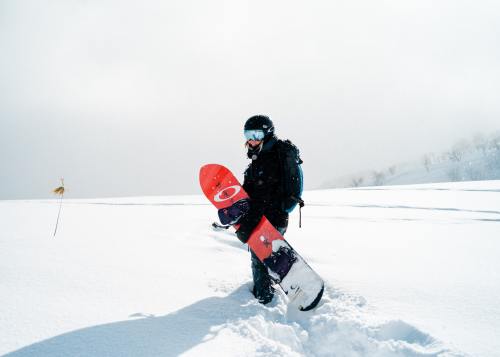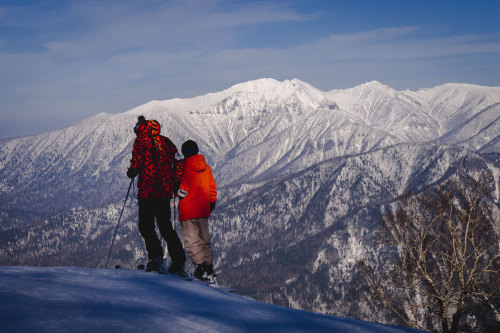#offthebeatentrack
DO: Ski Off-The-Beaten-Track
It’s no secret that Japan is home to some of the best skiing in the world. But whilst fair-weather skiers flock to big-name resorts, the more adventurous trek off the beaten track, rewarded by untouched slopes and the deepest, smoothest powder on the planet.
Read on for three of Japan’s best spots for back-country skiing.
Hakkoda, Aomori Prefecture
On the northern tip of mainland Japan, just south of Aomori City, eight powder-coated peaks make up what is widely considered the holy grail of Japan’s backcountry skiing. Not so much a ski resort as an off-piste playground, Hakkoda is home to only two marked courses, with the remainder of the mountain range reserved for exploring out-of-bounds.
Serviced only by the Hakkoda Ropeway and a handful of two-man chair lifts, Hakkoda is for advanced skiers and boarders only. Dotted with Japan’s famous Juhyo or ‘snow monsters’, no terrain is off-limits and those willing to make their own way down the mountain will be rewarded endless fresh tracks through one of the world’s most spectacular and surreal snowscapes. A circular road encompassing the mountain range makes arranging pick-up easy, though skiing with a guide and proper safety equipment is highly recommended.
Getting there: Hakkoda is best reached via Aomori, 3.5 hours north of Tokyo by train. From Aomori, travel an hour south-east by road – either by hire car, taxi, or one of several buses running from either of the city’s central stations.
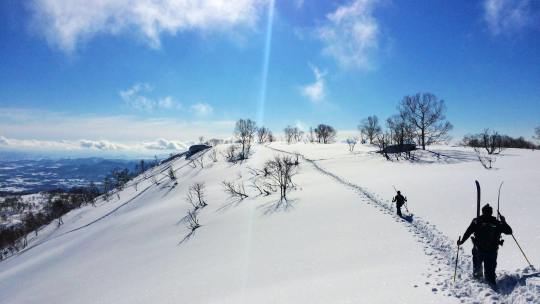
Asahidake and Kuradake, Hokkaido Prefecture
Deep in the heart of Japan’s largest and wildest national park, the Daisetsuzan Mountain Range boasts some of the best-quality snow in Japan. Siberian winds crossing the Sea of Japan lay vast blankets of thick, fresh snow throughout the winter months, making Daisetsuzan National Park a mecca for powderhounds and backcountry thrill-seekers.
Whilst Hokkaido is home to some of Japan’s best-known resorts, those looking to ski off-the-beaten-track head to Asahidake and Kuradake. Small on infrastructure, big on untouched slopes, both regions are serviced primarily by a single ropeway - ferrying visitors part way up the mountain from where they’re left largely to their own devices. Whilst this may sound terrifying to most, to those willing to trek the remainder of the way to the summit, equipment in hand, Daisetsuzan’s stripped-back ski regions promise some of the best rides of their lives.
Getting there: Daisetsuzan National Park is approximately 2.5 hours north of Sapporo and only accessible by road. Whilst buses run to both Asahidake and Kuradake, they are limited and slow, so car hire is highly recommended – though be sure to ask for a vehicle prepped to take on Hokkaido’s icy roads.
INSERT VIDEO: https://www.youtube.com/watch?v=Lq9ygwoofTc
Tanigawadake Tenjindaira, Gunma Prefecture
A string of mountain ranges across central Honshu offer Japan’s most easily accessible skiing, within striking distance of both Tokyo and Kyoto. Whilst a vast selection of well-serviced resorts offer fair-weather skiing to satisfy the majority of visitors, those in search of backcountry thrills should head to Tanigawadake Tenjindaira Snow Resort, or ‘Tenjin’ to locals. On the border of Gumna and Nigata Prefectures, serviced by the Tanigawadake Ropeway, Tenjin promises knee-deep powder and acres of off-piste terrain without travelling to the far north of Japan.
Like all of the best backcountry ski regions, there are only a handful of official courses and even fewer lifts. The rest of the mountain is free to explore, and true experts can hike beyond the resort to the big terrain beyond. But be warned, Tenjin’s off-piste is not for the faint-hearted, and with the risk of avalanche a genuine threat, a guide, the correct equipment and necessary level of skill are essential.
Getting there: Tenjin Ski Resort is located deep in the Joetsu National Park, 40km by road southeast of Yuzawa. The best way to get there is by train – Doai station is located just 1.5km from the Tanigawadake Ropeway, and is accessible from any major city. Alternatively, take one of the buses which run from Minakami train station, 25 minutes away.
Images: Alex Rebbeck for ANA
Post link
DO: Ski Off-The-Beaten-Track
It’s no secret that Japan is home to some of the best skiing in the world. But whilst fair-weather skiers flock to big-name resorts, the more adventurous trek off the beaten track, rewarded by untouched slopes and the deepest, smoothest powder on the planet.
Read on for three of Japan’s best spots for back-country skiing.
Hakkoda, Aomori Prefecture
On the northern tip of mainland Japan, just south of Aomori City, eight powder-coated peaks make up what is widely considered the holy grail of Japan’s backcountry skiing. Not so much a ski resort as an off-piste playground, Hakkoda is home to only two marked courses, with the remainder of the mountain range reserved for exploring out-of-bounds.
Serviced only by the Hakkoda Ropeway and a handful of two-man chair lifts, Hakkoda is for advanced skiers and boarders only. Dotted with Japan’s famous Juhyo or ‘snow monsters’, no terrain is off-limits and those willing to make their own way down the mountain will be rewarded endless fresh tracks through one of the world’s most spectacular and surreal snowscapes. A circular road encompassing the mountain range makes arranging pick-up easy, though skiing with a guide and proper safety equipment is highly recommended.
Getting there: Hakkoda is best reached via Aomori, 3.5 hours north of Tokyo by train. From Aomori, travel an hour south-east by road – either by hire car, taxi, or one of several buses running from either of the city’s central stations.
Asahidake and Kuradake, Hokkaido Prefecture
Deep in the heart of Japan’s largest and wildest national park, the Daisetsuzan Mountain Range boasts some of the best-quality snow in Japan. Siberian winds crossing the Sea of Japan lay vast blankets of thick, fresh snow throughout the winter months, making Daisetsuzan National Park a mecca for powderhounds and backcountry thrill-seekers.
Whilst Hokkaido is home to some of Japan’s best-known resorts, those looking to ski off-the-beaten-track head to Asahidake and Kuradake. Small on infrastructure, big on untouched slopes, both regions are serviced primarily by a single ropeway - ferrying visitors part way up the mountain from where they’re left largely to their own devices. Whilst this may sound terrifying to most, to those willing to trek the remainder of the way to the summit, equipment in hand, Daisetsuzan’s stripped-back ski regions promise some of the best rides of their lives.
Getting there: Daisetsuzan National Park is approximately 2.5 hours north of Sapporo and only accessible by road. Whilst buses run to both Asahidake and Kuradake, they are limited and slow, so car hire is highly recommended – though be sure to ask for a vehicle prepped to take on Hokkaido’s icy roads.
Tanigawadake Tenjindaira, Gunma Prefecture
A string of mountain ranges across central Honshu offer Japan’s most easily accessible skiing, within striking distance of both Tokyo and Kyoto. Whilst a vast selection of well-serviced resorts offer fair-weather skiing to satisfy the majority of visitors, those in search of backcountry thrills should head to Tanigawadake Tenjindaira Snow Resort, or ‘Tenjin’ to locals. On the border of Gumna and Nigata Prefectures, serviced by the Tanigawadake Ropeway, Tenjin promises knee-deep powder and acres of off-piste terrain without travelling to the far north of Japan.
Like all of the best backcountry ski regions, there are only a handful of official courses and even fewer lifts. The rest of the mountain is free to explore, and true experts can hike beyond the resort to the big terrain beyond. But be warned, Tenjin’s off-piste is not for the faint-hearted, and with the risk of avalanche a genuine threat, a guide, the correct equipment and necessary level of skill are essential.
Getting there: Tenjin Ski Resort is located deep in the Joetsu National Park, 40km by road southeast of Yuzawa. The best way to get there is by train – Doai station is located just 1.5km from the Tanigawadake Ropeway, and is accessible from any major city. Alternatively, take one of the buses which run from Minakami train station, 25 minutes away.
Images:Alex Rebbeck for ANA
Post link
GO: From the tropical south to the frozen north
Part Eight: Daisetsuzan to Tokyo
Our journey home began high in the mountains of Daisetsuzan National Park and ended back where we started, at Tokyo’s Haneda Airport. Read on to follow the final leg of our journey, that in just seven days took us from tropical Okinawa to icy Hokkaido.


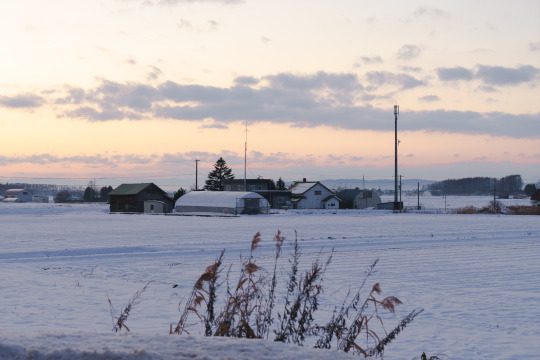
Wild Hokkaido: expansive landscapes define Japan’s northern isle, where the lowest population density of all 47 prefectures puts nature at the fore.
Leaving Mount Kuradake just as the light began to fade, our drive from Daisetsuzan National Park to Asahikawa Airport took us through Hokkaido’s characteristic rural landscape. Towering rock faces and forested peaks soon give way to broad horizons, where remote towns and snow-covered farmland fill expansive valleys. In Hokkaido, nature takes centre-stage and any road-trip through the prefecture’s breath-taking scenery is endlessly rewarding.
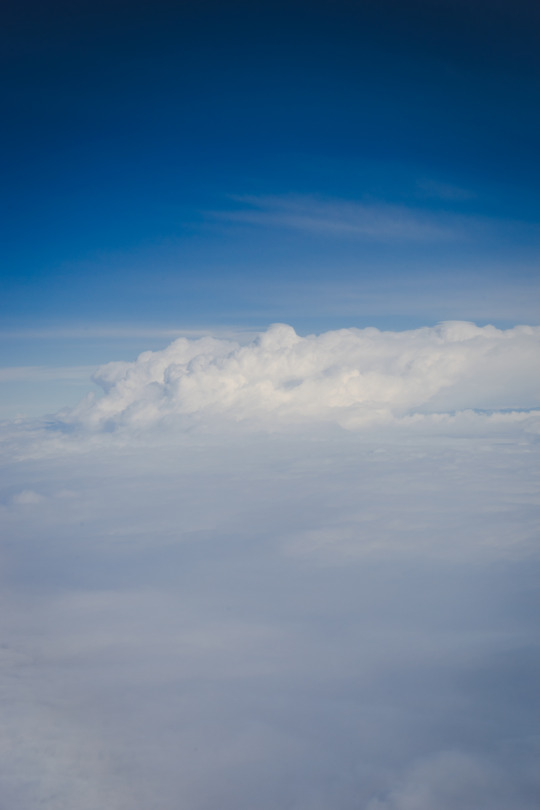

Hokkaido soft serve: No trip to Japan’s chilly northern tip is complete without sampling the country’s finest, and freshest, ice-cream.
Our journey through Japan had been made possible only by ANA’s extensive domestic flight network, making travel between the country’s far-flung prefectures staggeringly easy. Much like catching a train, each leg of our journey had proved speedy and hitch-free, with our final flight transporting us from remote Ashaikawa in central Hokkaido, back to bustling Tokyo in under two hours.
But whilst the journey was swift, we found time before boarding for one final taste of the region – a tub of creamy Hokkaido soft-serve – made using local milk, and arguably Japan’s tastiest ice-cream.

With our flight home to London departing the following morning, our last night in Japan was spent at Tokyo’s Haneda Airport, watching planes come and go from Excel Hotel Tokyu’s perfectly positioned bedroom windows. Heaven for plane-spotters, Excel Tokyu’s rooms overlooking Haneda airport’s domestic runway put guests nose-to-nose with the action, where watching Terminal Two’s busy comings and goings proves surprisingly mesmeric.
Last November, We Are Japan took a seven-day trip – exploring the country’s most remote corners to discover sand and soba, skiing and snow crab all in one week. Follow our trip over the coming weeks as we track our journey from the tropical south to the frozen north.
Post link

